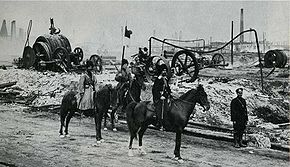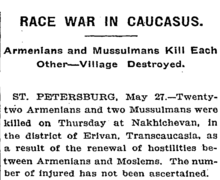Armenian–Tatar massacres of 1905–1907
This article has multiple issues. Please help improve it or discuss these issues on the talk page. (Learn how and when to remove these messages)
|
| Armenian–Tatar massacres | ||||||||
|---|---|---|---|---|---|---|---|---|
| Part of Revolution of 1905 | ||||||||
 A Cossack military patrol near the Baku oilfields, ca. 1905. | ||||||||
| ||||||||
| Belligerents | ||||||||
|
Armenian groups
| Caucasian Tatar groups[1] |
| ||||||
| Casualties and losses | ||||||||
|
128 Armenian and 158 Tatar villages destroyed [2] 3100 [3][4] to 10 000[5] Armenians and Caucasian Tatars killed | ||||||||
The Armenian–Tatar massacres (also known as the Armenian-Tartar war, the Armeno-Tartar war) refers to the bloody inter-ethnic confrontation between Armenians and Caucasian Tatars (later known as Azerbaijanis)[6][7] throughout the Russian Caucasus in 1905–1907.[8][9][10] The massacres started during the Russian Revolution of 1905. The most violent clashes occurred in 1905 in February in Baku, in May in Nakhchivan, in August in Shusha and in November in Elizabethpol, heavily damaging the cities and the Baku oilfields. Some violence, although of lesser scale, broke out also in Tiflis.
The clashes were not confined to the towns; 128 Armenian and 158 Tatar villages were sacked and ruined.[2] The total number of lives lost ranges is estimated between 3,100[3][4] to 10,000.[5] Another 15,000 people were uprooted. Svante Cornell states that ARF members on the Armenian side were more effective and Tatars being poorly organized, leading to more casualties on the Tatar side.[11] However, the Armenians sustained more than 75% of the property damage. [3][4]
According to historian Sen Hovhannisian, 4,000 people were wounded or killed as a result of the massacres. Moreover, 178 of 182 Armenian shops in Nakhichevan were looted and many Armenian villages were set on fire. Near Tiflis (present-day Tbilisi) on 23–25 November 1905, 500 Armenian volunteers protected the Armenian population consisting of 100,000 from "Tatar robbers".[12]
In Baku

Svante Cornell, a Swedish scholar from Stockholm-based Institute for Security and Development Policy, Central Asia-Caucasus Institute & Silk Road Studies Program (CACI) and American Foreign Policy Council, in his "Small nations and great powers: a study of ethnopolitical conflict in the Caucasus" provides various sources that give conflicting accounts on the Baku events.[13]

Sources such as British historian Christopher J. Walker (the author of Armenia: The Survival of a Nation,[15] Italian historian Luigi Villari[16] and Lebanese-Armenian historian Hratch Dasnabedian,[17] argue that the Azeris provoked the fighting, leading to a strong Armenian response. Villari claimed that Tatars had started the conflict by killing numerous unarmed Armenians in February 1905 which allowed the Armenian community to give a strong response. Dasnabedian claimed that the Azeris, ‘free to massacre with impunity’, ‘unleashed a war against the Armenians, with a clear intention to massacre, pillage, and destroy, killing unarmed Armenians in February 1905 in Baku, and later moving to other cities including Karabakh, which resulted in a response from the Dashnaks who managed to ‘stop the original momentum of the armed and destructive Azeri mobs’ and even ‘counterattack and sometimes severely punish’ the Azeris.
Georgian revolutionary Filip Makharadze, gives the number killed in Baku in February, 1905, as more than 1,000, most of whom were Armenians. [5]
On the other hand, Erich Feigl, an Austrian producer of films of Austrian-German-Turkish co-production and a denier of Armenian genocide[18] claimed that the Dashnaks committed terrorist acts (similar to those orchestrated in the Ottoman Empire) against the Azeri majority in Shusha, Baku and Ganja, leading to the eruption of violence and elimination of the most of the Azerbaijani leading stratum in Baku.[19] Charles van der Leeuw, a Baku-based Dutch correspondent known for stressing the need to obtain insight in “the other side of the story”, claimed that the riots started with the killing of an Azeri schoolboy and a shopkeeper in Baku, followed by Azeri mob's march on the Armenian quarters of Baku; and 126 Azeris and 218 Armenians killed within four days. According to the Baku Statistical Bureau, 205 Armenians and 111 Tatars were killed in the clashes, of which 9 were women, 20 were children, and 13 were elderly, along with 249 wounded.[20]
In Nakhichevan and Shusha

After the Baku clashes, Muslim communities in the Nakhchivan district began smuggling consignments of weapons from Persia. By April, murders of Armenians in the district began to assume alarming proportions and the Armenian community applied to the Russian authorities for protection. However, Luigi Villari describes the district's governor as "bitterly anti-Armenian" and the vice-governor in Yerevan as an "Armenophobe".[16]
On 25 May, acting on a previously arranged plan, bands of armed Tatars attacked the market area in the town of Nakhchivan, looting and burning Armenian businesses and killing any Armenians they could find. Approximately 50 Armenians were murdered and some of the Armenian shopkeepers were burnt alive in their shops. On the same day, Tatar villagers from the countryside began attacking their Armenian neighbours. Villari cites official reports mentioning that "out of a total of 52 villages with Armenian or mixed Armenian-Tartar populations, 47 were attacked, and of that 47, 19 were completely destroyed and abandoned by their inhabitants. The total number of dead, including those in Nakchivan town, was 239. Later, in a revenge attack, Armenians attacked a Tartar village, killing 36 people".[21]
The situation in Shusha was different than in Nakhchivan. According to the journalist Thomas de Waal, out of the 300 killed and wounded, about two-thirds were Tatars as the Armenians were better shooters and enjoyed the advantage of position.[22]
In Ganja
Prior to the Armenian-Tatar massacres, Ganja, known to Armenians as Gandzak (Template:Lang-hy][23][24][25]) had a sizable Armenian population.[26][27]
Analysis
According to the Russian-born American historian of Persian descent Firuz Kazemzadeh, writing in 1951: "it is impossible to pin the blame for the massacres on either side. It seems that in some cases (Baku, Elizavetpol) the Azerbaijanis fired the first shots, in other cases (Shusha, Tiflis) the Armenians."[28]

According to French writer Claude Anet, who in April 1905 crossed the Caucasus region by automobile, "the many minorities - and, in particular, Azeris (Tatars) and Armenians - resumed ancestral clashes". Anet wrote that the [Russian] government accused the Armenians of being the instigators but he believed the government was wrong. He explained that the Armenians, who formed the trading and active class, were not liked by the government, Muslim population and Georgians for being non-Orthodox (they formed a separate Church whose Catholicos resided in Etchmiadzin, near Yerevan), anti-government (the Armenians wanted a fair and strong political power that would protect them and therefore wanted the downfall of the autocratic and bureaucratic regime), "getting rich quickly at the expense of the populations in the midst of which they live and excelling in the money business like the Jews", "using bombs for defence instead of hand-to-hand combat". He wrote that "for a long time Russian policy was made in the Caucasus against the Armenians" and that "Russian policy aroused the Tatars against the Armenians, who themselves were not suspected of intellectualism".[29]
During the massacres, the government, despite its sufficient strength, did not intervene. Viceroy Vorontsov-Dashkov himself said that government forces had done nothing to prevent the massacres.[30]
See also
References
- ^ BUTCHERY IN THE CAUCASUS.; A State of Civil War -- 30,000 Combatants of Various Races The New York Times
- ^ a b E. Aknouni, Political Persecutions: Armenian Prisoners of the Caucasus (New York, 1911) p.30
- ^ a b c Ananun, op. cit., 9. 180
- ^ a b c Hovannisian, Richard G (1967). Armenia on the road to independence, 1918. Berkeley: University of California Press. p. 264. OCLC 1028172352.
- ^ a b c Filip Makharadze, Ocherki revolutsionnogo dvizheniia v Zakavkaz'e (Tiflis, 1927), pp. 300, 307
- ^ Suha Bolukbasi. Nation-building in Azerbaijan. Willem van Schendel (ed.), Erik Jan Zürcher (ed.). Identity politics in Central Asia and the Muslim world. I.B.Tauris, 2001. "Until the 1905—6 Armeno-Tatar (the Azeris were called Tatars by Russia) war, localism was the main tenet of cultural identity among Azeri intellectuals."
- ^ Joseph Russell Rudolph. Hot spot: North America and Europe. ABC-CLIO, 2008. "To these larger moments can be added dozens of lesser ones, such as the 1905-06 Armenian-Tartar wars that gave Azeris and Armenians an opportunity to kill one another in the areas of Armenia and Azerbaijan that were then controlled by Russia..."
- ^ "Azerbaijan | History, People, & Facts | Britannica". www.britannica.com.
- ^ Brockhaus and Efron Encyclopedic Dictionary. Turks
- ^ Willem van Schendel, Erik Jan Zürcher. Identity Politics in Central Asia and the Muslim World: Nationalism, Ethnicity and Labour in the Twentieth Century. I.B.Tauris, 2001. ISBN 1-86064-261-6, ISBN 978-1-86064-261-6, p. 43
- ^ Cornell, p. 56.
- ^ Hovhannisian, Sen (1 January 2019). Atlas of Armenia. Yerevan: Nahapet. p. 252. ISBN 978-9939-856-52-0. OCLC 1124982334.
- ^ Cornell, p. 55.
- ^ "RACE WAR IN CAUCASUS.; Armenians and Mussulmans Kill Each Other -- Village Destroyed". The New York Times. 28 May 1905.
- ^ Walker, Christopher, Armenia and Karabagh: The Struggle for Unity, London, Minority Rights Group, 1991.
- ^ a b Villari, p. 270.
- ^ Hratch Dasnabedian, History of the Armenian Revolutionary Federation Dashnaktsutiun 1890/1924, Milano: Oemme, 1990, p81.
- ^ Feigl, Erich. A Myth of Terror : Armenian Extremism, Its Causes and Its Historical Context, page 7.
- ^ Erich Feigl, Un Mythe de la Terreur: Le Terrorisme Arménien, ses Origines et ses Causes, Salzburg: Druckhaus Nonntal, 1991, p214–15
- ^ Saint-Peterburg Vedomosti, 25 May 1905
- ^ Villari, pp. 270-274.
- ^ de Waal, Thomas (2003). Black Garden: Armenia and Azerbaijan Through Peace and War. New York: New York University Press. p. 190. ISBN 978-0-8147-1945-9.
- ^ "the union of Georgian and Armenian armies near Gandzak", Армянская Советская Социалистическая Республика, Great Soviet Encyclopedia
- ^ "Mkhitar Gosh was born in Gandzak", Мхитар Гош, Great Soviet Encyclopedia
- ^ John A. Boyle (1961). "The death of the last 'Abbasid Caliph': a contemporary Muslim account". Journal of Semitic Studies. 6 (2): 145–161. doi:10.1093/jss/6.2.145.
Gandzak (Ganja)
- ^ Soviet Census in 1926-1979, Newspaper Pravda Press, Moscow, 1983
- ^ According to the 1892 official data, "10524 of 25758 inhabitants of the city were Armenians, there were 6 Armenian Apostolic (Gregorian) churches", Elizavetpol article, Brockauz and Efron Encyclopedia (in Russian)
- ^ Firuz Kazemzadeh. Struggle For Transcaucasia (1917—1921), New York Philosophical Library, 1951, pp. 18-19
- ^ Anet, Claude (1 February 1990). ""Who are we killing ? The Armenians" - A French witness in Baku 1905". Le Monde diplomatiqueLe Monde diplomatique. Paris: Le Monde. p. 11. Retrieved 12 September 2021.
- ^ Kazemzadeh 1951, p. 19.
Bibliography
- Cornell, S. (2005) Small Nations and Great Powers: A Study of Ethnopolitical Conflict in the Caucasus, Routledge Curzon: London. ISBN 9780700711628
- Luigi Villari (1906), Fire and Sword in the Caucasus [1], London, T. F. Unwin, ISBN 0-7007-1624-6
- Thomas De Waal (2004), Black Garden: Armenia and Azerbaijan Through Peace and War, NYU Press, ISBN 978-0-8147-1945-9
- * Firuz Kazemzadeh (1951). The Struggle for Transcaucasia (1917-1921). New-York: Hyperion Press. ISBN 9780830500765.
- Mass murder in 1905
- Mass murder in 1906
- Mass murder in 1907
- 1905 in the Russian Empire
- 1906 in the Russian Empire
- 1907 in the Russian Empire
- 1905 in Georgia (country)
- 1906 in Georgia (country)
- 1907 in Georgia (country)
- Massacres in 1905
- Massacres in 1906
- Massacres in 1907
- Massacres in Armenia
- Massacres in Azerbaijan
- Massacres of Armenians
- 1905 in Armenia
- 1906 in Armenia
- 1907 in Armenia
- 1905 in Azerbaijan
- 1906 in Azerbaijan
- 1907 in Azerbaijan
- Armenia–Azerbaijan relations
- History of the Caucasus under the Russian Empire


